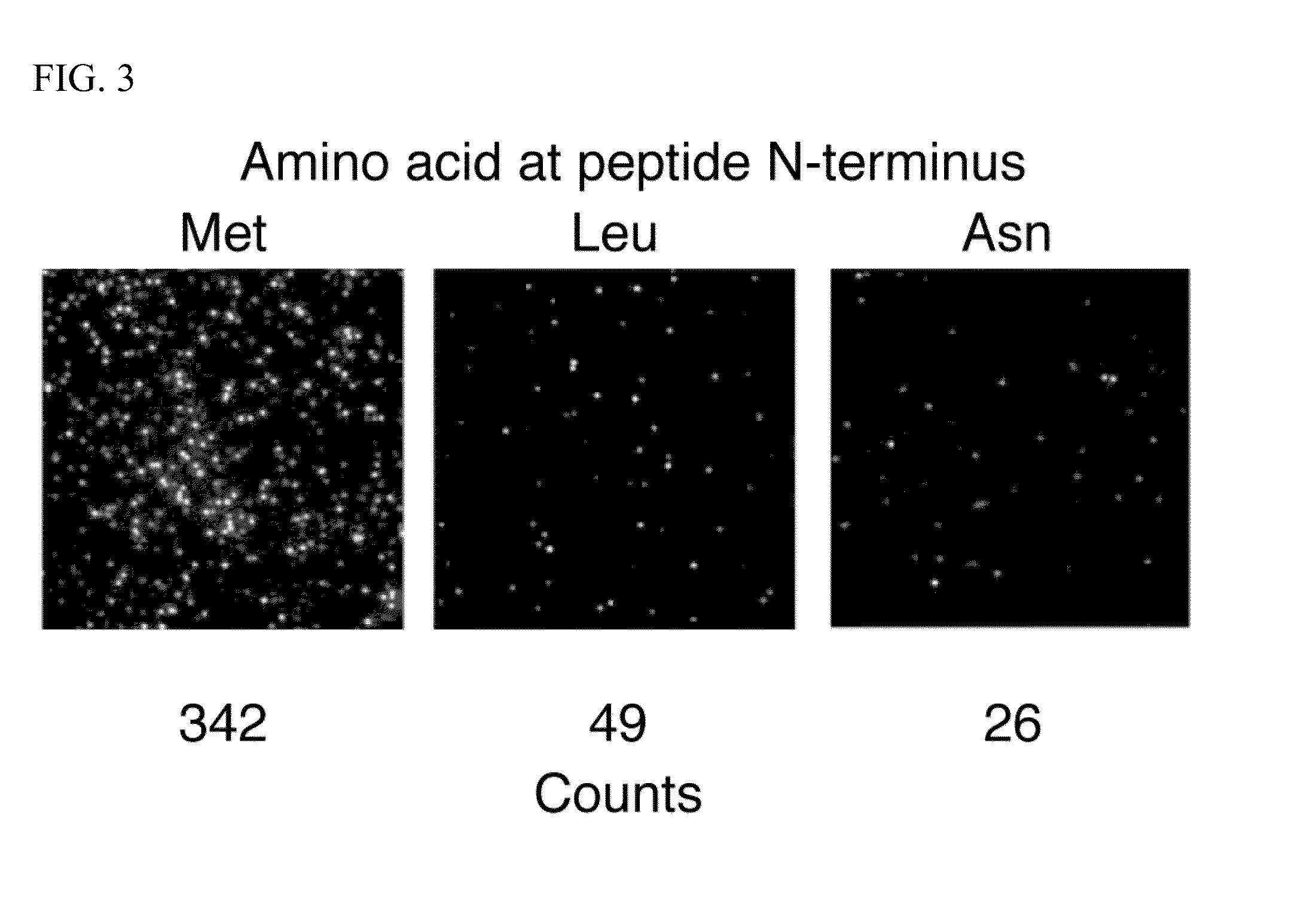Molecules and methods for iterative polypeptide analysis and processing
a technology of polypeptides and molecules, applied in the field of molecules and methods for iterative polypeptide analysis and processing, can solve the problems of quantification, difficult to compare relative amounts between two samples without isotopic labeling, and limitations of mass spectrometry
- Summary
- Abstract
- Description
- Claims
- Application Information
AI Technical Summary
Benefits of technology
Problems solved by technology
Method used
Image
Examples
example 1
eLAP: a NAAB that Specifically Binds to N-Terminal Leucine Residues
[0127]In this example, an E. coli methionine aminopeptidase (eMAP) was modified to create a NAAB that binds specifically to N-terminal leucine residues. Two mutually compatible leucine-contacting interactions were identified from the protein data bank (PDB) (15) that could be incorporated into the eMAP structure. The surrounding protein residues of eMAP were redesigned around these two interactions. The resulting NAAB for leucine (eLAP) has 19 amino acid mutations relative to eMAP.
[0128]The eMAP and eLAP proteins were expressed and assayed for binding against a panel of peptides with different N-termini. The NAAB for N-terminal leucine amino acids was non-specifically labeled with Cy5 fluorophore on lysine side chains. Synthetic peptides with either N-terminal methionine, leucine, or asparagine amino acids were coupled to a nanogel surface by thiol linkage. An additional experiment was performed with no peptide added...
example 2
A NAAB that Specifically Binds to N-Terminal Methionine Residues
[0130]In this example, a truncated version of wild-type E. coli methionyl-tRNA synthetase (MetRS) from E. coli. was modified to make a NAAB that binds specifically to N-terminal methionine residues. A truncated version of MetRS (residues 1-547) having three amino acid mutations (L13S, Y260L, and H301L) that had been shown to pre-organize the binding site towards the methionine-bound conformation was obtained (16). A crystal structure is available of this mutant bound to free methionine (pdb code: 3h99). An additional mutation (D296G) was introduced to provide a more open binding pocket capable of accommodating a peptide and avoid steric clashes. This mutation was introduced into MetRS and the altered protein was expressed in E. coli. The gene encoding MetRS from genomic DNA was amplified and was cloned into the pET42a expression vector between the MfeI and XhoI sites. This yielded a genetic fusion of a thrombin-cleavabl...
example 3
A NAAB that Specifically Binds to N-Terminal Histidine Residues
[0132]In this example, a histidine-tRNA synthetase (HISRS) from E. coli was modified to create a NAAB that binds specifically to N-terminal histidine residues. The fragment of wild-type HisRS from 1-320 was shown to be monomeric by others. After inspecting the crystal structure of HisRS, further residues were truncated from both ends. The initial fragment tested has from Lysine3 to Alanine180. Protein design was conducted to replace a long loop near the binding site with a shorter loop that would create a more open pocket and result in tighter binding to N-terminal histidine residues. This involved the replacement of an 11 residue loop (from Arginine113 to Lysine123) with a 4 residue turn, wherein the four residues of the inserted turn are Glycine, Asparagine, Alanine, and Proline. Thus, this NAAB comprises an internally truncated version of wild-type E. coli HisRS (residues 3-180; SEQ ID NO: 10) having seven fewer resid...
PUM
| Property | Measurement | Unit |
|---|---|---|
| temperature | aaaaa | aaaaa |
| melting temperature | aaaaa | aaaaa |
| volumes | aaaaa | aaaaa |
Abstract
Description
Claims
Application Information
 Login to View More
Login to View More - R&D
- Intellectual Property
- Life Sciences
- Materials
- Tech Scout
- Unparalleled Data Quality
- Higher Quality Content
- 60% Fewer Hallucinations
Browse by: Latest US Patents, China's latest patents, Technical Efficacy Thesaurus, Application Domain, Technology Topic, Popular Technical Reports.
© 2025 PatSnap. All rights reserved.Legal|Privacy policy|Modern Slavery Act Transparency Statement|Sitemap|About US| Contact US: help@patsnap.com



